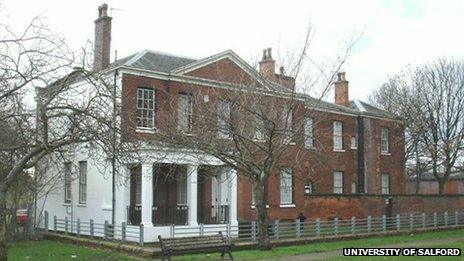Peterloo Massacre barracks to be excavated
- Published

The Grade II listed officers' quarters and mess are used as a community centre
The barracks that housed troops responsible for the Peterloo Massacre are to be excavated by archaeologists.
Manchester's Hulme Barracks, which were occupied from 1804 to 1915, were the home of the 15th King's Hussars.
In 1819, the cavalrymen charged reform campaigners in the city's St Peter's Field, leaving 15 dead and 700 injured. It was dubbed the Peterloo Massacre.
The dig, which will see the public working with University of Salford experts, will take place in July.
The massacre, which was remembered in Percy Bysshe Shelley's political poem The Masque of Anarchy and widely condemned at the time, has been described by historians as a "world changing event".
It has been claimed it led to the rise of the Chartist Movement, from which grew trade unions, resulted in the establishment of the Manchester Guardian and paved the way towards ordinary people being given the vote.
'High profile excavation'
A spokesman for the university said the archaeologists hoped to discover "a wide selection of finds" on the site, which was reported to house up to 399 hussars and 20 officers at the height of its use in 1839.
The buildings stopped being a cavalry barracks in 1895 and were used by infantry battalions before it was sold to the Manchester Corporation in 1914.
The corporation demolished the majority of the site but kept the Grade II listed officers' quarters and mess, which was used as a bowling green clubhouse before being handed to the St George's Community Association.
The spokesman said there had been "no building work on the site since it was demolished, so there are high hopes of recovering soldiers' equipment and everyday items from over 100 years of continuous occupation".
He said any finds would help show "Manchester's development from a garrison town into one of the world's greatest industrial cities".
The university's senior archaeologist Brian Grimsditch said it was unusual for the public to be involved in such an "extremely high profile excavation".
"However, members of the community will be able to find out more about a site that spans over 100 years of the city's explosive development," he said.
- Published16 August 2012
- Published14 August 2011